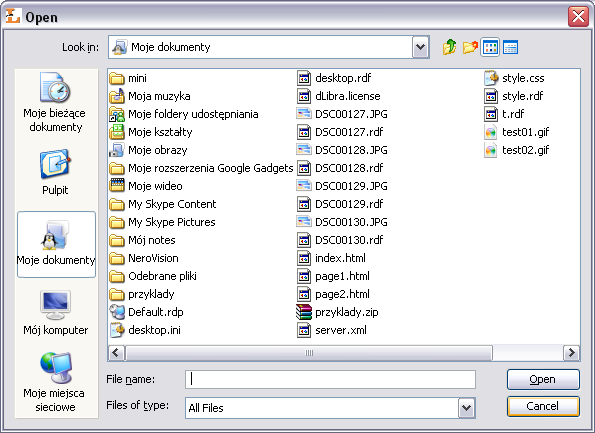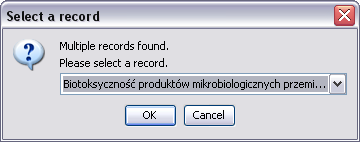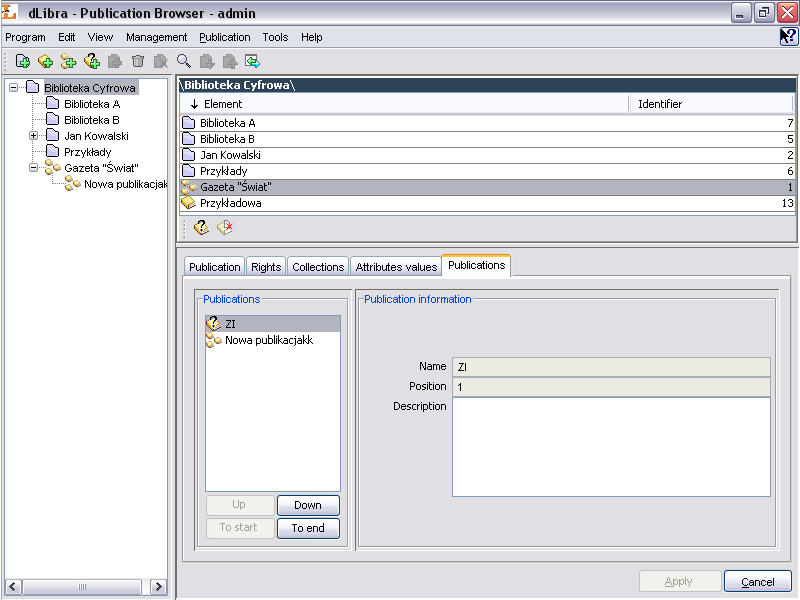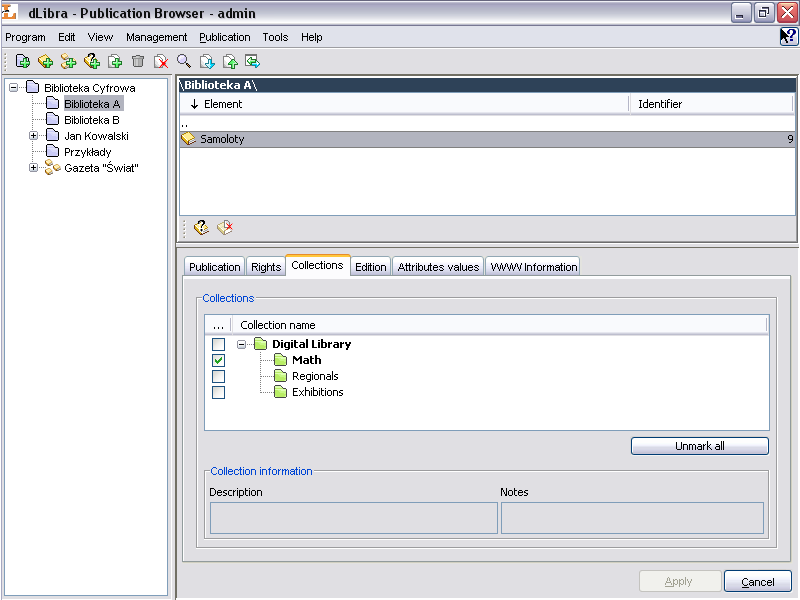The main window of the Editor's Application is divided into five parts:
Directories tree placed on the left side of editor's application main window. It presents hierarchical structure of the library,
List of elements placed on top right part of the main window. It presents a list of elements,
Properties Window (on the right bottom part) which presents properties of an element chosen on the list of elements,
Main menu placed on the top of the editor's application,
Toolbar (placed below the main menu) enabling convenient access to most common operations (e.g. creating new publication).
Default editor application view presented above can be configured by the user. User may change components in places where elements list and properties window is placed. In both places user may put either element list or properties window. So it is possible to compare properties of two elements (when properties window is in both places) or manipulate on two lists.
In order to change component where by default elements list is placed (top right corner) press ALT+F1 - properties window will replace elements list. In order to get back to elements list, press ALT+F1 again. In order to change component where by default properties window is presented (bottom right corner), press ALT+F2 - elements list will show up, to get back to properties window, press ALT+F2 again.
The directories tree is placed on the left side of the editor's application. Directories allow editors and administrators to order hierarchically elements in the library. Directories are visible only for editors and administrators (it is not visible for WWW users). Directories tree may contain:
 directory node - represents a library directory, may contain
subdirectories and group publications,
directory node - represents a library directory, may contain
subdirectories and group publications, group publication node - represents a group publication, which may
contain publications.
group publication node - represents a group publication, which may
contain publications.
With every node a context menu is associated that provides quick access to the most common operations performed on a given type of element (e.g. creating a publication). Context menu may be called by clicking the right mouse button on a node.
Elements list allows user to browse the content of the digital library. By default, elements from the main directory are listed on the elements list. You can open an element on the list by doubleclicking on it or by pressing ENTER key (when the element is selected). In order to go one level up press BACKSPACE key or doubleclick element on the first position - “..” (this elements is not displayed when main directory is opened as there is no higher level than main directory). The path to currently opened element is displayed on the top of the elements list.
When user selects an element on the list properties window (bottom left part of the window) is filled with information about the selected element.
Types of elements possible on the elements list:
 directory node - represents a library directory, may contain
subdirectories and publications,
directory node - represents a library directory, may contain
subdirectories and publications, group publication node - represents a group publication, which may
contain publications including group publications.
group publication node - represents a group publication, which may
contain publications including group publications. planned publication node - represents planned
publication and does not contain nodes.
planned publication node - represents planned
publication and does not contain nodes. publication node - represents a publication, in advanced mode
contains publication editions nodes and publication files node,
whereas in simple mode when publication has only one edition
contains files versions of this edition,
publication node - represents a publication, in advanced mode
contains publication editions nodes and publication files node,
whereas in simple mode when publication has only one edition
contains files versions of this edition, removed content publication node - represents
publication which content was removed, contains only publication
editions nodes.
removed content publication node - represents
publication which content was removed, contains only publication
editions nodes. edition
node - represents an edition of a publication, contains all
versions of publication files that compose the edition,
edition
node - represents an edition of a publication, contains all
versions of publication files that compose the edition, publication files node
- contains all publication files
publication files node
- contains all publication files- folder node (folder icon the same as in operating system) - represents a folder that groups publication files or publications files versions,
- publication file node (icon depends on the file type) - represents a publication file, contains all versions of the file
- version node (icon depends on the file type) - represents a single version of a publication file
With every node a context menu is associated that provides quick access to the most common operations performed on a given type of element (e.g. adding new files versions). Context menu is called by clicking a right mouse button on a node.
Two toggle buttons are placed on the bottom of the elements list. These buttons allow to hide specific elements. Currenlty, it is possible to hide planned publications and publications with removed content.
Publication
The structure of publication is described in ???. In addition, publication in dLibra system may be secured. Only HTML (up to version 3.2 - higher versions may be incorrectly displayed) publications can be secured. Secuirity mechanism disallows reader to copy, save or print publication content.
“Properties Window” consist of a set of tabs (the number depends on the chosen element's type). Each tab contains properties editor which allows user to change some properties of selected element. Pressing the button will store the information from tabs on the server. Pressing the button or selecting another element on the elements list will discard all changes made since the last operation. Values of some properties (eg. edition description) can be defined in a number of languages - the current language can be changed with the drop down list placed on the bottom right corner of the “Properties Window”.
General information editor allows user to view/modify element's main properties, for example directory name for directory element. General information editor is usually the first tab in the properties window.
The list below shows properties for different library objects:
Library directory:
- Name - defines name of a directory identifying it in dLibra system; directory name is language independent,
- Notes - administrative notes for a directory; notes content is language independent,
Library collection:
- Name - defines name of a collection identifying it in dLibra system and visible in WWW application; collection name is language dependent and should be defined for each language separately,
- Description - defines description and contains basic information about collection, visible also in WWW application; collection description is language dependent and should be defined for each language separately,
- Notes - administrative notes for a collection; notes content is language independent,
Publication (planned, normal and light deleted):
- Name - defines name of a publication identifying it in dLibra system; publication name is language independent and is visible only in Editor's Application and Library Manager,
- Notes - administrative notes for a publication; notes content is language independent,
Edition:
- Name - defines name for an edition which is language independent; edition name is visible in WWW application,
- Description - description defines certain edition and contains basic information about it (eg. abstract) visible also in WWW application; edition description is language dependent and should be defined for each language separately,
- Comment - comment contains additional information about the edition (eg. information about errors or damages in case of old books scans) visible also in WWW application; edition comment is language dependent and should be defined for each language separately,
- Notes - administrative notes for an edition; notes content is language independent,
Miniature - a picture representing a miniature of an edition; if miniature is chosen, it will bew seen in web application.
dLibra system provides an advanced attributes' values (bibliographic description) management mechanism to allow describing library elements with metadata. More information about the mechanism can be found in Appendix E, Attributes' values' Synonyms Dictionary. The idea of synonyms dictionary is described in attributes dictionary appendix. In this section only basic information is presented about how the system works and how it influences the way user describes directories, group publications and editions with metadata.
Attributes' values are kept in a system in a special dictionary. It is built separately for each language and each attribute. Therefore it is allowed for a value to exist more than once, singly for each attribute. Values of every attribute are divided into groups of synonyms. The same value may exist in many groups, for instance if it has many meanings. Describing library resources with metadata rest on choosing a set of values for some attributes. If a value doesn't exist in a dictionary, it is possible to add it using Publication Browser.
The Attributes' Values Editor (???) allows user to modify bibliographic description of edition, group publication or directory. Bibliographic description of an edition is essential for searching mechanism in the reader's application (WWW pages). Description of a group publication is inherited by all the group publications and editions placed lower in the inheritance hierarchy. Directory description is a default bibliographic descritpion for all newly created editions of any publication in this directory, as well as for group publication for which this directory is a direct parent.
Attributes' Values Editor is available on Attributes values tab. It allows user to describe a library element with a set of attributes available in system. Bibliographic description is presented in a table with two columns. Attributes tree is placed in the left column, values assigned to attributes are in the right column. Every attribute may have many values. Every value is presented in separate row starting from the row with attribute name. If an attribute has no values assigned then the field on the right side of an attribute name is empty.
When Show with inherited values check box is selected the table with bibliographic description is filled up with attributes' values inherited from overriding group publications. button removes all attributes' values from the table.
In order to add value to an attribute which has no value assigned:
Choose an empty field on the rights side of attribute's name (e.g. clik left mouse button on it) to which you want to add a value,
Enter the value you want to add,
Approve the operation by pressing the ENTER key.
In order to add value to an attribute which have at least one value assigned:
Choose a field with value assigned to the attribute,
Press the TAB key - a new row will be added (below selected row)
Enter the value you want to add,
Approve the operation by pressing the ENTER key.
While entering attribute's value it is possible to press the TAB key. It will add the current value to attribute's values list and create a new row in which next value can be added.
Autocomplete mechanism will be started if current value matches any value of the attribute's dictionary. The autocomplete mechanism shows the list of attribute's values (see Figure 3.3, “Attribute's values list shown by the autocomplete mechanism” ) which start with current value. The user may select the value from the autocomplete list (e.g. by double clicinkg on its name).
Attribute's value can be removed from the attribute's values list. In order to do it select a value on the list and press DELETE key (on keyboard). The value will be removed from the bibliographic description (if there was only one value --- the field with it will be cleared, if there was more than one value --- the row with selected value will be removed).
Attention! In order to save attributes' values (bibliographic description) press (the bottom right corner of the “Properties Window”).
If equivocal value is present in bibliographic description user must choose the meaning of the value. In order to do this application pops up choose group window (see Figure 3.4, “Group selection for a value” ) so the user could choose the group (the meaning) that the equivocal value belongs to. An example: Let us assume that the bibliographic description contains the blue value and the dLibra system have to groups of values which contain blue - sad group and divine group. In such case the user have to decide either the blue is a color (divine group) or it is a state of mind (sad group).
The bibliographic description is language dependent which means that the user may specify metadata in a number of languages. To view/modify bibliographic description in specific language user have to select appropriate tab. The name of the tab is two-letter abbreviation of the language name and it is pictured by the icon representing the language.
Let us assume that in our library we provide bibliographic description in two languages (English and Polish). In order to provide an author of a specific publication the editor has to put this value in both languages. In order to modify this value the editor has to modify it in both languages (separatelly for each language). In such situation the author value is universal, which means that it concerns two languages (the same value should be provided for each language). In order to simplify creation of bibliographic description in such situations special universal language has been added to dLibra system (marked as “Univ.” on bibliographic description editor tab). This language is created only for editors to make their work easier (bibliographic description in universal language is not visible on WWW pages). Values from the universal language are automatically added to bibliographic description of other languages when presenting these on WWW pages.
For example, let us assume that in editor and administrator application we have typed the value of “Title” attribute in universal language for edition A. On edition A WWW page the user see this value in every language. The bibliographic description presented in concrete language (e.g. Polish or English) is filled with values from universal language - all the values from universal language are added to bibliographic description of a language selected on WWW page. Please notice that values from universal language are added (not replaced) to values of other languages.
Attributes' values editor allows bibliographic description to be imported from external file which structure is in specific format. Digital library administrator may add so called extensions to application in order to enable metadata import in specific format. By default extensions for the following formats are added:
MARC 21 communication format (details can be found in application configuration and Appendix A, MARC import extension).
XML format (default configuration allows to import metadata from RDF and MASTER format, details can be found in application configuration and Appendix B, Export to RDF format).
Bibtex format (details can be found in application configuration and Appendix A, MARC import extension).
In order to import metadata from external resource, press button. Metadata ( Figure 3.5, “Metadata import dialog”) import dialog will show up.
The metadata import dialog allows user to specify the source of the bibliographic description (file or URL to file) and the format of the source file. Press button to import metadata from the selected source. When Automatically detect option is selected, application tries to detect source format and import the metadata automatically.
If the file to import contains more that one set of metadata the application will ask the user to choose one. ( Figure 3.6, “Choose metadata set”).
Attributes' values editor allows bibliographic description to be exported to external file which will be saved in specific format. Digital library administrator may add so called extensions to application in order to enable metadata export in specific format. By default extensions for the following formats are added:
RDF format (see application configuration and Appendix B, Export to RDF format for details on conversion configuration).
In order to export metadata to a file, press button. Metadata ( Figure 3.7, “Metadata export dialog”) export dialog will show up.
The metadata export dialog allows user to specify the destination file and the format of the destination file. Press button to export metadata.
The Right Editor ( Figure 3.8, “Right Editor - publication rights”) enables user to alter users access rights to publication.
There are three rights which can be granted to a user (or group of users) for selected publication:
- View - The permission to read all published editions of a publication.
- Read - The permission to read all editions of a publication.
- Manage - The permission to manage the publication (e.g. to create a new edition or grant access rights).
Every right can have one of five states:
- Granted - The permission is granted directly to the user.
- From group - The user is a member of a group that has the right granted.
- Inherited - The permission is granted to some of the parent objects (e.g. a parent directory).
- Implied - The permission is granted because of another right granted (e.g. a user who has a Manage right for a publication has also an implied Read right to the publication).
- Not granted - The right is not granted at all.
Rights to publication can be also assigned in administrator application ( Section 4.3.5, “Publication-level permissions”).
Group publication may contain other publications which are ordered by an editor. Publications are displayed on the WWW according to the order specified by an editor. By default, newly added publication appears on the last position. It is possible to manipulate publication position using publication position editor ( Figure 3.9, “Publication position editor - publication positioning”).
Using the , , or buttons on the Publications panel user may change position of selected publication. Basic information about selected publication are presented on the Publication information panel.
Collections are grouped in a library in hierarchical structure. Each collection may contain any number of subcollections. On every level of this structure a collection may be assigned a publication. Any number of publications may belong to a single collection. If publication belongs to a collection it implies that it also belongs to all its supercollections on the path to main library collection.
Collections editor allows user to assign publication to a number of collections. When publication or group publication is selected on the elements list the collection editor is available on the Collections tab.
To assign a collection to selected on the elements list publication check appropriate check box. To remove the assignment deselect appropriate check box. Check boxes are placed on the left side of the collection's name.
If the collection icon is green ( ) it means that currently logged user
has rights to manage this collection and may change the assignment of a
publication. Red icon (
) it means that currently logged user
has rights to manage this collection and may change the assignment of a
publication. Red icon ( ) indicates that user do not have
appropriate rights to change the assignment of the publication in a
collection.
) indicates that user do not have
appropriate rights to change the assignment of the publication in a
collection.
If a collection name is marked with a bold font it means that selected publication will belong to this collection (directly or indirectly). When collection is checked all its supercollection are also marked with a bold font. It means that the selected publication is indirectly assigned to all supercollections and directly assigned to checked collection.
All the changes must be applied using the button. Choosing different element or clicking the button discards all changes since the last apply action.








